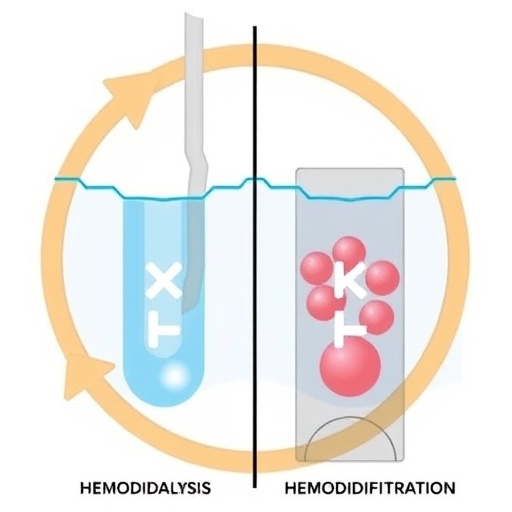In recent advancements in the field of renal replacement therapies, the focus has shifted to understanding the fouling processes associated with hemodiafiltration membranes. This is paramount in enhancing the efficacy of hemodialysis and hemodiafiltration therapy, which are critical for patients suffering from end-stage renal disease. The innovative study led by Tange, Kawakami, and Takesawa, published in the Journal of Artificial Organs, sheds light on the complexities of membrane fouling—an issue that significantly affects the performance of dialysis treatments.
The intricate dynamics of membrane fouling have far-reaching implications for patient outcomes. Hemodiafiltration, which combines the principles of hemodialysis and diffusion, has emerged as a promising alternative to conventional hemodialysis. However, the fouling of membranes during the filtration process remains a formidable challenge. It impacts not only the efficiency of solute removal but also the overall safety and longevity of the dialysis systems used in clinical settings.
To fully understand the fouling process, it is essential to explore the various factors contributing to this phenomenon. Membrane fouling is primarily attributed to the accumulation of proteins, lipids, and other macromolecules on the membrane surface. This accumulation leads to increased resistance and, consequently, reduced filtration efficiency. The relationship between membrane characteristics, such as pore size and surface charge, and fouling behavior has been an area of significant interest among researchers.
One of the novel findings from the study by Tange et al. indicates that the choice of dialysate composition plays a crucial role in the fouling process. By carefully selecting the ionic and osmotic properties of the dialysate, it may be possible to mitigate fouling and enhance the performance of hemodiafiltration membranes. This finding not only highlights the importance of customized therapy but also underscores the need for ongoing research into optimizing dialysate formulations.
Moreover, the study reveals that the type of therapy itself—whether hemodialysis or hemodiafiltration—can influence the degree of membrane fouling observed. Hemodialysis, characterized by its reliance on diffusion for solute removal, may lead to different fouling characteristics compared to the convective mechanisms employed in hemodiafiltration. Investigating these differences could pave the way for developing targeted strategies to minimize fouling and improve patient care.
In the clinical context, the authors emphasize the implications of fouling for treatment frequency and duration. As fouling accelerates the decline in membrane function, patients may require more frequent treatments or longer dialysis sessions. This not only affects their quality of life but also places additional burdens on healthcare systems. The insights gained from this research could lead to more personalized treatment plans that optimize the dialysis experience for patients.
Another critical aspect examined in this study is the role of membrane cleaning and maintenance protocols. Regular maintenance is essential for prolonging the lifespan of dialysis membranes and ensuring their optimal performance. The findings suggest that implementing effective cleaning strategies could significantly reduce the fouling layer’s thickness, thereby restoring membrane functionality and enhancing patient outcomes.
The interplay between membrane material properties and fouling resilience is another intriguing area explored in this research. Using cutting-edge materials science techniques, the authors delve into how different membrane compositions can inherently resist fouling. By engineering membranes with specific surface characteristics, it may be possible to develop next-generation dialysis filters that maintain high efficiency over extended periods.
The insights offered by Tange and colleagues could potentially lead to a paradigm shift in how dialysis treatment is approached. Given the increasing prevalence of chronic kidney disease worldwide, improving the performance of hemodialysis and hemodiafiltration membranes has never been more critical. The implications of their research extend beyond individual therapies, hinting at broader applications in the biomedical field, such as enhancing filtration processes in other organ support systems.
In conclusion, the research conducted by Tange, Kawakami, and Takesawa not only addresses a pivotal challenge in dialysis therapy but also opens up avenues for future investigation. As the field of artificial organs continues to evolve, the findings reported in this study underscore the necessity of interdisciplinary collaboration among biochemists, materials scientists, and clinical practitioners to fully harness the potential of hemodiafiltration therapies.
In summary, ongoing research into membrane fouling highlights the importance of understanding the intricate mechanics of dialysis therapies. The work of Tange and his team emphasizes the need for targeted strategies to combat fouling, optimize treatment protocols, and ultimately improve the quality of life for patients undergoing renal replacement therapies. The scientific community eagerly anticipates further developments in this vital area, which has the potential to transform patient care in the arena of end-stage renal disease.
As researchers continue to explore the multifactorial nature of membrane fouling, the importance of incorporating patient-specific parameters will become increasingly evident. The ultimate goal is to create tailored dialysis experiences that not only extend the life of artificial organs but also enhance the overall health outcomes for patients. The findings from this study are a crucial step in that direction.
By addressing the fouling process comprehensively, Tange, Kawakami, and Takesawa contribute significantly to the growing body of literature aiming to enhance the efficiency and effectiveness of hemodialysis and hemodiafiltration. This work not only broadens our understanding of membrane behavior but also stresses the critical need for innovation in therapeutic strategies for renal replacement therapies.
Subject of Research: Membrane fouling in hemodialysis and hemodiafiltration therapy.
Article Title: Fouling process of hemodiafiltration membranes by hemodialysis and hemodiafiltration therapy.
Article References:
Tange, Y., Kawakami, M. & Takesawa, S. Fouling process of hemodiafiltration membranes by hemodialysis and hemodiafiltration therapy.
J Artif Organs 28, 408–414 (2025). https://doi.org/10.1007/s10047-025-01497-9
Image Credits: AI Generated
DOI: https://doi.org/10.1007/s10047-025-01497-9
Keywords: Membrane fouling, hemodialysis, hemodiafiltration, dialysis therapy, renal replacement therapy.




